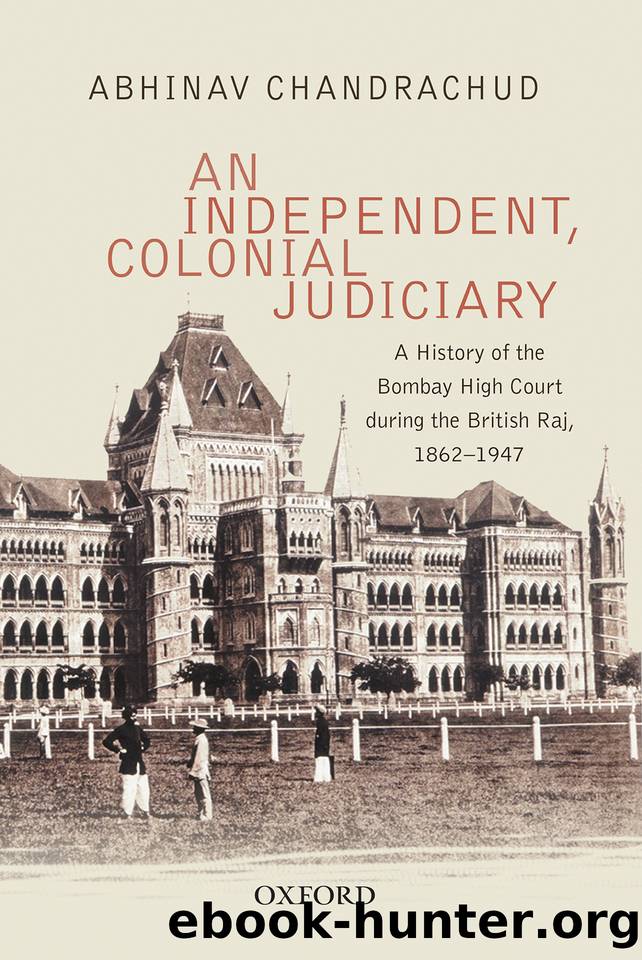An Independent, Colonial Judiciary: A History of the Bombay High Court during the British Raj, 1862–1947 by Chandrachud Abhinav

Author:Chandrachud, Abhinav [Chandrachud, Abhinav]
Language: eng
Format: epub
Publisher: OUP India
Published: 2015-05-27T16:00:00+00:00
BENCH COMPOSITION
The High Court did not (and continues not to) convene in plenary sessions, but in benches of one judge (‘Single Judge’), two judges (‘Division Bench’), or in rare cases, three or more 49 judges (‘Full Bench’). It was the Chief Justice’s prerogative to compose benches and to assign cases to judges. On the Original Side, cases were usually suits and miscellaneous applications like motions or chamber summonses, which were heard by Single Judges, and appeals from decisions of Single Judges, which were heard by Division Benches. On the Appellate Side, cases came up in appeal from the decisions of mofussil judges. Appeals were usually ‘second appeals,’ 50 meaning that a case which was originally decided by a subordinate judge (usually of the first or second class), was then appealed before an intermediate appellate court like the District Court or Sessions Judge, and the intermediate appellate court’s decision was now being appealed before the High Court. Full Bench decisions were rare, and were usually reserved for cases in which there was a difference of opinion between two judges on a Division Bench, or if conflicting precedents had been set by different decisions of the High Court.
We have seen in Chapter 1 that though the Supreme Court and Court of Sudder Dewannee and Sudder Foujdaree Adawlut of Bombay were merged to form the High Court in 1862, they continued to sit separately until 1879, as the Original Side and Appellate Side. In fact, we saw that lawyers often referred to the Appellate Side of the High Court in those years as the ‘the Sudder’. However, the data suggest that during that time, the judges of the two divisions of the court did not sit separately. In 1865, for example, barrister judges, who would have been considered Original Side judges, sat with Civilian judges on the Appellate Side in Mazgaon, and Civilian judges sometimes also sat with barrister judges on the Original Side at Hornby House .
Barrister judges most often decided cases on the Original Side, throughout the court’s colonial history. Approximately 71 per cent of the reported Original Side cases at the court were decided by a single barrister judge sitting by himself, or by a Division Bench in which at least one of the two judges was a barrister. 51 Apart from the Original Side, a barrister judge was more likely to be used on the Appellate Side than in criminal cases. While 54 per cent of Appellate Side cases were decided by benches which had barrister judges, only 26 per cent of the court’s criminal cases were decided by benches which had barrister judges.
Civilian judges most often decided cases on the Appellate Side, to which they were more suited, since they had a better knowledge of the rural districts of British India than barrister judges. Accordingly, approximately 78 per cent of the reported Appellate Side cases of the court were decided by a bench in which at least one judge was a Civilian. 52 Since reported Appellate Side cases
Download
This site does not store any files on its server. We only index and link to content provided by other sites. Please contact the content providers to delete copyright contents if any and email us, we'll remove relevant links or contents immediately.
| Africa | Americas |
| Arctic & Antarctica | Asia |
| Australia & Oceania | Europe |
| Middle East | Russia |
| United States | World |
| Ancient Civilizations | Military |
| Historical Study & Educational Resources |
Magic and Divination in Early Islam by Emilie Savage-Smith;(1500)
Ambition and Desire: The Dangerous Life of Josephine Bonaparte by Kate Williams(1344)
Bohemians, Bootleggers, Flappers, and Swells: The Best of Early Vanity Fair by Bohemians Bootleggers Flappers & Swells- The Best of Early Vanity Fair (epub)(1343)
Papillon by Henry Charrière(1310)
Twelve Caesars by Mary Beard(1256)
Operation Vengeance: The Astonishing Aerial Ambush That Changed World War II by Dan Hampton(1136)
What Really Happened: The Death of Hitler by Robert J. Hutchinson(1129)
London in the Twentieth Century by Jerry White(1114)
Time of the Magicians by Wolfram Eilenberger(1089)
The Japanese by Christopher Harding(1086)
Twilight of the Gods by Ian W. Toll(1084)
Lenin: A Biography by Robert Service(1045)
The Devil You Know by Charles M. Blow(985)
A Social History of the Media by Peter Burke & Peter Burke(936)
Freemasons for Dummies by Hodapp Christopher;(922)
Napolean Hill Collection by Napoleon Hill(902)
Henry III by David Carpenter;(891)
The Churchill Complex by Ian Buruma(881)
The Rise and Triumph of the Modern Self by Unknown(879)
